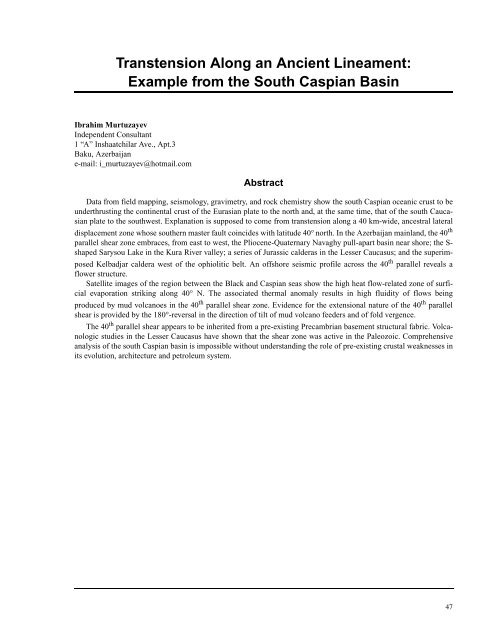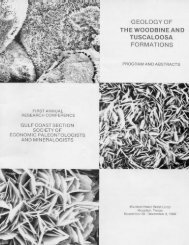Petroleum Systems of Deep-Water Basins - Gulf Coast Section SEPM
Petroleum Systems of Deep-Water Basins - Gulf Coast Section SEPM
Petroleum Systems of Deep-Water Basins - Gulf Coast Section SEPM
You also want an ePaper? Increase the reach of your titles
YUMPU automatically turns print PDFs into web optimized ePapers that Google loves.
Transtension Along an Ancient Lineament:<br />
Example from the South Caspian Basin<br />
Ibrahim Murtuzayev<br />
Independent Consultant<br />
1 “A” Inshaatchilar Ave., Apt.3<br />
Baku, Azerbaijan<br />
e-mail: i_murtuzayev@hotmail.com<br />
Abstract<br />
Data from field mapping, seismology, gravimetry, and rock chemistry show the south Caspian oceanic crust to be<br />
underthrusting the continental crust <strong>of</strong> the Eurasian plate to the north and, at the same time, that <strong>of</strong> the south Caucasian<br />
plate to the southwest. Explanation is supposed to come from transtension along a 40 km-wide, ancestral lateral<br />
displacement zone whose southern master fault coincides with latitude 40° north. In the Azerbaijan mainland, the 40 th<br />
parallel shear zone embraces, from east to west, the Pliocene-Quaternary Navaghy pull-apart basin near shore; the S-<br />
shaped Sarysou Lake in the Kura River valley; a series <strong>of</strong> Jurassic calderas in the Lesser Caucasus; and the superimposed<br />
Kelbadjar caldera west <strong>of</strong> the ophiolitic belt. An <strong>of</strong>fshore seismic pr<strong>of</strong>ile across the 40 th parallel reveals a<br />
flower structure.<br />
Satellite images <strong>of</strong> the region between the Black and Caspian seas show the high heat flow-related zone <strong>of</strong> surficial<br />
evaporation striking along 40° N. The associated thermal anomaly results in high fluidity <strong>of</strong> flows being<br />
produced by mud volcanoes in the 40 th parallel shear zone. Evidence for the extensional nature <strong>of</strong> the 40 th parallel<br />
shear is provided by the 180°-reversal in the direction <strong>of</strong> tilt <strong>of</strong> mud volcano feeders and <strong>of</strong> fold vergence.<br />
The 40 th parallel shear appears to be inherited from a pre-existing Precambrian basement structural fabric. Volcanologic<br />
studies in the Lesser Caucasus have shown that the shear zone was active in the Paleozoic. Comprehensive<br />
analysis <strong>of</strong> the south Caspian basin is impossible without understanding the role <strong>of</strong> pre-existing crustal weaknesses in<br />
its evolution, architecture and petroleum system.<br />
47

















